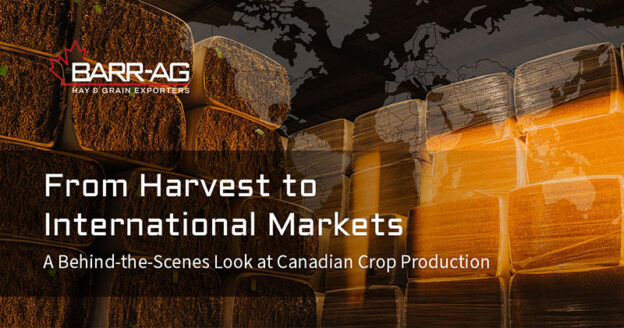At Barr-Ag, quality and consistency are at the heart of everything we do. We recognize that many factors play a role in crop quality, which is why our focus on careful handling and quality control at every stage. From the fields of Canada to farms around the world, every crop we handle, including hay, straw, grains, pulses, and corn, goes through a process designed to protect its value and meet the needs of our customers.
Hay: Cut, Cured, and Ready to Ship
The hay season typically runs from the end of June through September. The process begins with cutting the hay and allowing it to dry in the field before baling. Once baled, hay is stored in sheds to protect it from moisture and the elements. To ensure stable moisture levels and prevent heating or damage during shipping, hay undergoes a natural curing period of six to eight weeks after baling.
Throughout this process, we follow quality checks such as sampling and monitoring moisture levels to help preserve quality. After curing, hay is either pressed and prepared for shipping or dried in our dehy facility and pressed into bales or processed into pellets. These steps help Barr-Ag hay maintain its quality during transport and storage, providing dependable feed for livestock in many markets around the world.
Straw: From Swath to Storage
Straw harvest begins once grain crops are ready, typically from late August through October. Barr-Ag purchases straw directly from farmers in the swath, bales it, and transports it to our yard for storage in sheds. This helps maintain export standards, though in some cases straw is stacked in the field and hauled over the winter.
Grains and Pulses: Stored for Quality
In addition to hay and straw, Barr-Ag also handles grains, peas, lentils, and other crops. These are harvested in late summer to early fall and either sold directly to elevators or stored in bins. While fewer of these crops are exported, proper storage and regular quality checks are essential to maintain their condition and value.
Corn: From Chop to Silage
Corn is harvested differently from hay and straw. At Barr-Ag, chopped corn is hauled directly to our yard and packed into a large silage pit. The pit is continuously packed as loads arrive, ensuring efficient use of space and proper fermentation. Once all fields have been harvested, the pit is sealed with plastic and weighted with straw bales. The silage remains closed for at least 90 days before being opened, fluffed, and dried in our dehy facility. This process helps corn silage retain nutritional value for livestock feed.
A Variety of Products and Bale Types
Barr-Ag offers a range of bale types and weights for hay, straw, and processed crops. Customers can choose from traditional bales, pellets, or processed feed depending on their needs. Detailed product sheets are available for both domestic and international buyers.
Delivering Quality to Global Markets
Every step of Barr-Ag’s process, from harvest and curing to storage, production, and shipping, includes quality checks that help maintain consistency. While we cannot control every factor that affects crops, our goal is to do everything we can to protect quality and provide dependable products. By combining careful practices with modern facilities, Barr-Ag is proud to deliver Canadian crops that farmers around the world can rely on.




